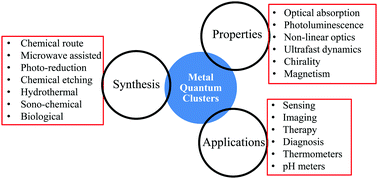当前位置:
X-MOL 学术
›
J. Mater. Chem. B
›
论文详情
Our official English website, www.x-mol.net, welcomes your
feedback! (Note: you will need to create a separate account there.)
Fluorescent metal quantum clusters: an updated overview of the synthesis, properties, and biological applications
Journal of Materials Chemistry B ( IF 6.1 ) Pub Date : 2017-10-23 00:00:00 , DOI: 10.1039/c7tb02320k Puneet Khandelwal 1, 2, 3, 4 , Pankaj Poddar 1, 2, 3, 4
Journal of Materials Chemistry B ( IF 6.1 ) Pub Date : 2017-10-23 00:00:00 , DOI: 10.1039/c7tb02320k Puneet Khandelwal 1, 2, 3, 4 , Pankaj Poddar 1, 2, 3, 4
Affiliation

|
Metal quantum clusters are evolving as excellent systems for a wide range of biological applications due to their small size (∼2 nm), tunable optical properties, including optical absorption, photoluminescence (UV to NIR), nonlinear optical properties (two-photon absorption, two-photon fluorescence, and second/third harmonic generation), ultrafast dynamics (relaxation kinetics, electron–phonon coupling, and radiative emission), and magnetism. These excellent properties have resulted in their use in a broad range of applications, including the sensing of ions (heavy metal ions, anions), biomolecules (proteins, DNA, miRNA, and enzymes), biological cells, diagnosis, and therapy. This article presents an introduction to metal quantum clusters, including a brief history of research in this system and an overview of the existing theories to understand their properties. We also discuss the synthesis methods, the various properties of quantum clusters and present a broad and updated overview of the applications of metal quantum clusters in biology.
中文翻译:

荧光金属量子团簇:合成,性质和生物学应用的最新概述
金属量子簇由于尺寸小(〜2 nm),可调节的光学特性(包括光吸收,光致发光(从UV到NIR),非线性光学特性(双光子吸收,双光子荧光和二次/三次谐波产生),超快动力学(弛豫动力学,电子-声子耦合和辐射发射)和磁性。这些优异的性能使其可以在广泛的应用中使用,包括离子感测(重金属离子,阴离子),生物分子(蛋白质,DNA,miRNA和酶),生物细胞,诊断和治疗。本文介绍了金属量子簇,包括该系统的简要研究历史以及对了解其特性的现有理论的概述。我们还将讨论合成方法,量子团簇的各种性质,并提供有关金属量子团簇在生物学中的应用的广泛且更新的概述。
更新日期:2017-11-09
中文翻译:

荧光金属量子团簇:合成,性质和生物学应用的最新概述
金属量子簇由于尺寸小(〜2 nm),可调节的光学特性(包括光吸收,光致发光(从UV到NIR),非线性光学特性(双光子吸收,双光子荧光和二次/三次谐波产生),超快动力学(弛豫动力学,电子-声子耦合和辐射发射)和磁性。这些优异的性能使其可以在广泛的应用中使用,包括离子感测(重金属离子,阴离子),生物分子(蛋白质,DNA,miRNA和酶),生物细胞,诊断和治疗。本文介绍了金属量子簇,包括该系统的简要研究历史以及对了解其特性的现有理论的概述。我们还将讨论合成方法,量子团簇的各种性质,并提供有关金属量子团簇在生物学中的应用的广泛且更新的概述。











































 京公网安备 11010802027423号
京公网安备 11010802027423号